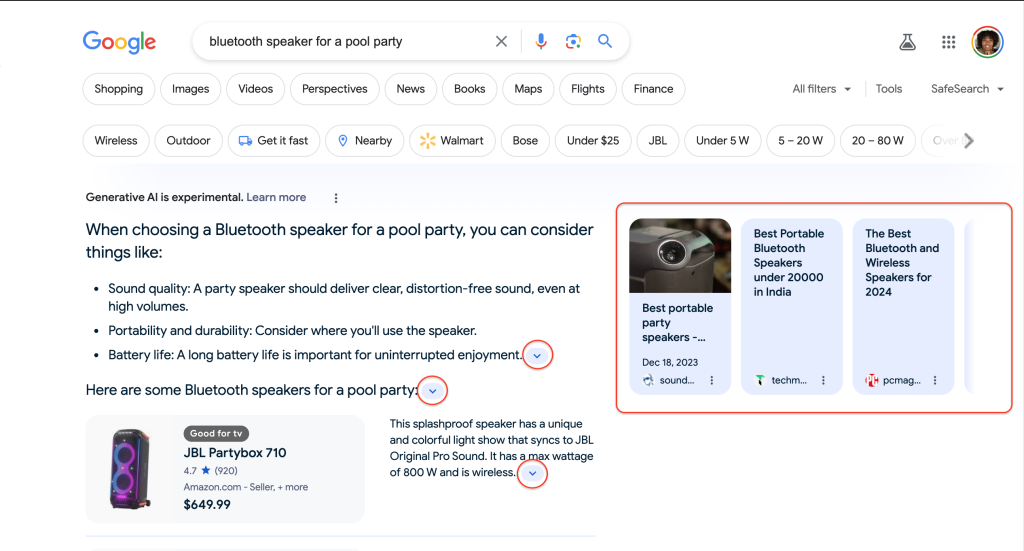In the ever-evolving landscape of digital marketing and search engine optimization (SEO), staying ahead of the curve is crucial for online visibility. One of the latest frontiers in this domain is Google’s Search Generative Experience (SGE), a dynamic feature reshaping the way websites are recommended to users. Understanding and optimizing for SGE has become a paramount objective for businesses seeking prominence in search results.
This comprehensive guide aims to demystify the intricacies of Google’s SGE, providing a roadmap for digital marketers and website owners to navigate this innovative search experience successfully. From the fundamental principles that underpin SGE ranking to actionable strategies for achieving visibility, we will delve into the essentials of mastering this cutting-edge aspect of SEO. Join us on a journey to unlock the full potential of your online presence as we explore the nuances of Google’s Search Generative Experience.
Understanding the Basics
In the ever-competitive realm of online visibility, the foundation of traditional SEO practices remains indispensable for success in Google’s Search Generative Experience (SGE). Before delving into the nuances of SGE optimization, it’s imperative to reinforce the fundamentals that set the stage for effective ranking.
The Importance of Existing SEO Practices:
To even be considered for SGE, a website must already have pages that rank on Google. This involves adhering to time-tested SEO practices, including the creation of high-quality content. Crafting content that not only answers user queries but does so in a thorough and engaging manner lays the groundwork for SEO.
Building backlinks to target pages is another cornerstone. Google sees backlinks from relevant websites as votes of confidence from other websites, signaling the authority and relevance of your content. Internal linking within your website further enhances the user experience (UX) and contributes to your site’s overall SEO health.
Topical authority is a concept gaining prominence in the SEO landscape. Establishing your website as an authority in a specific niche or industry can significantly boost its chances of being recognized by Google’s SGE.
Ways to Appear in SGE Results
1. Top Right Carousel
In the visual landscape of SGE results, the top right carousel stands out prominently. This carousel displays links to three websites related to the user’s query. Although only three results are visible by default, users can scroll right to reveal additional recommendations. Securing a spot in this carousel is a coveted achievement, emphasizing the importance of being among the top three visible links.
2. Dropdown Arrows
The dropdown arrows within SGE’s results usually reveals additional website links that are not be immediately visible.

3. Follow-Up Questions
SGE often generates additional follow-up questions that users may wish to explore, often featuring links to websites that provide more detailed information.

4. Becoming an Authority:
Elevating your brand to the status of an authority within your niche can have a profound impact on SGE recognition. Just as Google associates Netflix with top streaming platforms, establishing your brand as synonymous with certain queries within your industry requires strategic positioning and consistent delivery of valuable content.
Optimizing for SGE Recommendations
Step One: On-Page Optimization
The heart of SGE optimization lies in the meticulous crafting of on-page content. To increase the likelihood of your website being recommended, prioritize providing concise and exact-match answers to user queries. Place these answers strategically at the top of your webpage, ensuring immediate visibility upon landing. Using exact-match keywords and employing straightforward, easy-to-understand sentences not only aids in SGE recognition but also enhances the overall user experience.
Step Two: Submit Page URL to Google Search Console (GSC)
Once your on-page content is fine-tuned, the next crucial step is to expedite the indexing process by submitting your URL through Google Search Console (GSC). This step ensures that the latest version of your webpage is considered for inclusion in SGE results promptly. The submission process is straightforward but warrants attention to detail for optimal results.
1. Access Google Search Console:
- Log in to your GSC account.
- Navigate to the “URL Inspection” tool.
- Submit the URL:
2. Enter the specific URL you want to submit.
- Click on “Request Indexing.”
- Monitor the Results:
3. Keep an eye on the indexing status.
- Verify successful indexing through GSC.
- By combining effective on-page optimization with prompt URL submission through GSC, you enhance the chances of your content being promptly recognized and recommended by Google’s Search Generative Experience.
Final Thoughts
In conclusion, mastering Google’s Search Generative Experience requires a holistic approach that encompasses both traditional SEO practices and specialized strategies tailored for SGE visibility. The landscape of digital marketing is evolving, and SGE represents a paradigm shift in how search results are presented to users.
By understanding the basics, optimizing for diverse SGE results, and implementing meticulous on-page strategies, businesses and website owners can position themselves at the forefront of this innovative search experience. Adaptability and a proactive approach to evolving search engine algorithms will be key to sustained success in the dynamic world of online visibility.
Want to stay informed about emerging marketing trends so you can consistently refine your strategies to align with the ever-changing digital landscape? Subscribe to our newsletter!
The journey to mastering SGE is a continuous one, and by implementing the insights shared in this guide, you’re well on your way to unlocking the full potential of your online presence.




0 Comments